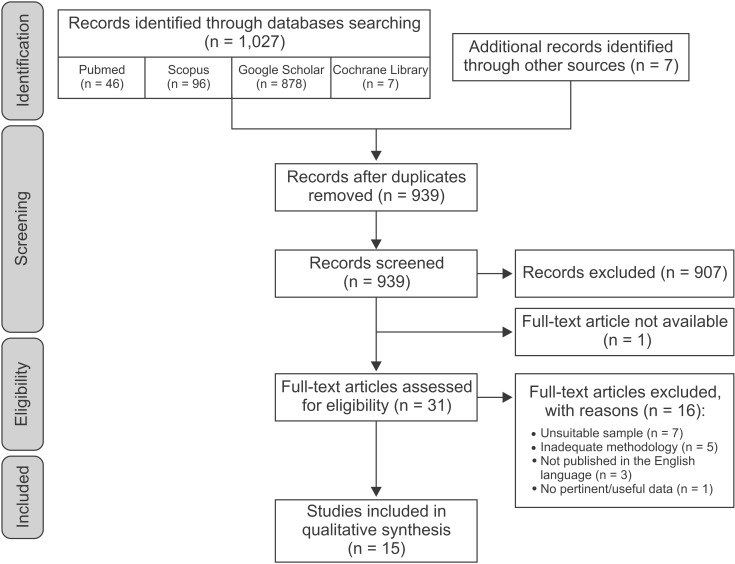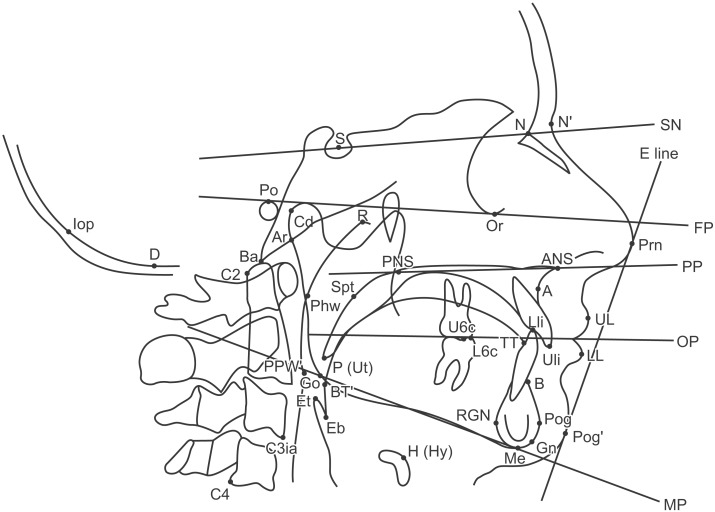Korean J Orthod.
2015 Nov;45(6):308-321. 10.4041/kjod.2015.45.6.308.
Cephalometric predictors of treatment outcome with mandibular advancement devices in adult patients with obstructive sleep apnea: a systematic review
- Affiliations
-
- 1Unit of Orthodontics, Department of Biomedical and Neuromotor Sciences, University of Bologna, Bologna, Italy. giulio.alessandri@unibo.it
- 2Department of Orthodontics, University of Brescia, Brescia, Italy.
- 3Department of Neuroscience, Reproductive Science and Oral Science, University of Naples "Federico II", Naples, Italy.
- 4Department of Pediatric Surgery, Bambino Gesu Children's Hospital, Rome, Italy.
- KMID: 2130593
- DOI: http://doi.org/10.4041/kjod.2015.45.6.308
Abstract
OBJECTIVE
The efficacy of mandibular advancement devices (MADs) in the treatment of obstructive sleep apnea (OSA) ranges between 42% and 65%. However, it is still unclear which predictive factors can be used to select suitable patients for MAD treatment. This study aimed to systematically review the literature on the predictive value of cephalometric analysis for MAD treatment outcomes in adult OSA patients.
METHODS
The MEDLINE, Google Scholar, Scopus, and Cochrane Library databases were searched through December 2014. Reference lists from the retrieved publications were also examined. English language studies published in international peer-reviewed journals concerning the predictive value of cephalometric analysis for MAD treatment outcome were considered for inclusion. Two review authors independently assessed eligibility, extracted data, and ascertained the quality of the studies.
RESULTS
Fifteen eligible studies were identified. Most of the skeletal, dental, and soft tissue cephalometric measurements examined were widely recognized as not prognostic for MAD treatment outcome; however, controversial and limited data were found on the predictive role of certain cephalometric measurements including cranial base angle, mandibular plane angle, hyoid to mandibular plane distance, posterior nasal spine to soft-palate tip distance, anterior nasal spine to epiglottis base distance, and tongue/oral cross sectional area ratio thus justifying additional studies on these parameters.
CONCLUSIONS
Currently available evidence is inadequate for identification of cephalometric parameters capable of reliably discriminating between poor and good responders to MAD treatment. To guide further research, methodological weaknesses of the currently available studies were highlighted and possible reasons for their discordant results were analyzed.
MeSH Terms
Figure
Cited by 2 articles
-
Clustering of craniofacial patterns in Korean children with snoring
Stephanie Maritza Anderson, Hoi-Jeong Lim, Ki-Beom Kim, Sung-Wan Kim, Su-Jung Kim
Korean J Orthod. 2017;47(4):248-255. doi: 10.4041/kjod.2017.47.4.248.Effects of bodily retraction of mandibular incisors versus mandibular setback surgery on pharyngeal airway space: A comparative study
Byeong-Tak Keum, Sung-Hwan Choi, Yoon Jeong Choi, Hyoung-Seon Baik, Kee-Joon Lee
Korean J Orthod. 2017;47(6):344-352. doi: 10.4041/kjod.2017.47.6.344.
Reference
-
1. Epstein LJ, Kristo D, Strollo PJ Jr, Friedman N, Malhotra A, Patil SP, et al. Clinical guideline for the evaluation, management and long-term care of obstructive sleep apnea in adults. J Clin Sleep Med. 2009; 5:263–276. PMID: 19960649.2. Skomro RP, Kryger MH. Clinical presentations of obstructive sleep apnea syndrome. Prog Cardiovasc Dis. 1999; 41:331–340. PMID: 10406327.
Article3. Sullivan CE, Issa FG, Berthon-Jones M, Eves L. Reversal of obstructive sleep apnoea by continuous positive airway pressure applied through the nares. Lancet. 1981; 1:862–865. PMID: 6112294.
Article4. Waldhorn RE, Herrick TW, Nguyen MC, O'Donnell AE, Sodero J, Potolicchio SJ. Long-term compliance with nasal continuous positive airway pressure therapy of obstructive sleep apnea. Chest. 1990; 97:33–38. PMID: 2403899.
Article5. Mehta A, Qian J, Petocz P, Darendeliler MA, Cistulli PA. A randomized, controlled study of a mandibular advancement splint for obstructive sleep apnea. Am J Respir Crit Care Med. 2001; 163:1457–1461. PMID: 11371418.
Article6. Kushida CA, Morgenthaler TI, Littner MR, Alessi CA, Bailey D, Coleman J Jr, et al. Practice parameters for the treatment of snoring and Obstructive Sleep Apnea with oral appliances: an update for 2005. Sleep. 2006; 29:240–243. PMID: 16494092.
Article7. Ferguson KA, Cartwright R, Rogers R, Schmidt-Nowara W. Oral appliances for snoring and obstructive sleep apnea: a review. Sleep. 2006; 29:244–262. PMID: 16494093.
Article8. Hoekema A, Doff MH, de Bont LG, van der Hoeven JH, Wijkstra PJ, Pasma HR, et al. Predictors of obstructive sleep apnea-hypopnea treatment outcome. J Dent Res. 2007; 86:1181–1186. PMID: 18037652.
Article9. Shen HL, Wen YW, Chen NH, Liao YF. Craniofacial morphologic predictors of oral appliance outcomes in patients with obstructive sleep apnea. J Am Dent Assoc. 2012; 143:1209–1217. PMID: 23115150.
Article10. Endo S, Mataki S, Kurosaki N. Cephalometric evaluation of craniofacial and upper airway structures in Japanese patients with obstructive sleep apnea. J Med Dent Sci. 2003; 50:109–120. PMID: 12715927.11. Saffer F, Lubianca JF, Rösing C, Dias C, Closs L. Predictors of success in the treatment of obstructive sleep apnea syndrome with mandibular repositioning appliance: a systematic review. Int Arch Otorhinolaryngol. 2015; 19:80–85. PMID: 25992156.
Article12. Jovell AJ, Navarro-Rubio MD. Evaluation of scientific evidence. Med Clin (Barc). 1995; 105:740–743. PMID: 8523956.13. Liu Y, Lowe AA. Factors related to the efficacy of an adjustable oral appliance for the treatment of obstructive sleep apnea. Chin J Dent Res. 2000; 3:15–23. PMID: 11314530.14. Kim YK, Kim JW, Yoon IY, Rhee CS, Lee CH, Yun PY. Influencing factors on the effect of mandibular advancement device in obstructive sleep apnea patients: analysis on cephalometric and polysomnographic parameters. Sleep Breath. 2014; 18:305–311. PMID: 23928957.
Article15. Lee CH, Mo JH, Choi IJ, Lee HJ, Seo BS, Kim DY, et al. The mandibular advancement device and patient selection in the treatment of obstructive sleep apnea. Arch Otolaryngol Head Neck Surg. 2009; 135:439–444. PMID: 19451462.
Article16. Lee CH, Kim JW, Lee HJ, Seo BS, Yun PY, Kim DY, et al. Determinants of treatment outcome after use of the mandibular advancement device in patients with obstructive sleep apnea. Arch Otolaryngol Head Neck Surg. 2010; 136:677–681. PMID: 20644062.
Article17. Liu Y, Lowe AA, Fleetham JA, Park YC. Cephalometric and physiologic predictors of the efficacy of an adjustable oral appliance for treating obstructive sleep apnea. Am J Orthod Dentofacial Orthop. 2001; 120:639–647. PMID: 11742309.
Article18. Marklund M, Franklin KA, Stenlund H, Persson M. Mandibular morphology and the efficacy of a mandibular advancement device in patients with sleep apnoea. Eur J Oral Sci. 1998; 106:914–921. PMID: 9786320.
Article19. Menn SJ, Loube DI, Morgan TD, Mitler MM, Berger JS, Erman MK. The mandibular repositioning device: role in the treatment of obstructive sleep apnea. Sleep. 1996; 19:794–800. PMID: 9085488.
Article20. Milano F, Billi MC, Marra F, Sorrenti G, Gracco A, Bonetti GA. Factors associated with the efficacy of mandibular advancing device treatment in adult OSA patients. Int Orthod. 2013; 11:278–289. PMID: 23867336.
Article21. Mostafiz W, Dalci O, Sutherland K, Malhotra A, Srinivasan V, Darendeliler MA, et al. Influence of oral and craniofacial dimensions on mandibular advancement splint treatment outcome in patients with obstructive sleep apnea. Chest. 2011; 139:1331–1339. PMID: 21292761.
Article22. Ng AT, Darendeliler MA, Petocz P, Cistulli PA. Cephalometry and prediction of oral appliance treatment outcome. Sleep Breath. 2012; 16:47–58. PMID: 21424283.
Article23. Rose E, Lehner M, Staats R, Jonas IE. Cephalometric analysis in patients with obstructive sleep apnea. Part II: Prognostic value in treatment with a mandibular advancement device. J Orofac Orthop. 2002; 63:315–324. PMID: 12198746.24. Svanholt P, Petri N, Wildschiødtz G, Sonnesen L. Influence of craniofacial and upper spine morphology on mandibular advancement device treatment outcome in patients with obstructive sleep apnoea: a pilot study. Eur J Orthod. 2015; 37:391–397. PMID: 25351571.
Article25. Liberati A, Altman DG, Tetzlaff J, Mulrow C, Gøtzsche PC, Ioannidis JP, et al. The PRISMA statement for reporting systematic reviews and meta-analyses of studies that evaluate healthcare interventions: explanation and elaboration. BMJ. 2009; 339:b2700. PMID: 19622552.
Article26. Hoekema A, Hovinga B, Stegenga B, De Bont LG. Craniofacial morphology and obstructive sleep apnoea: a cephalometric analysis. J Oral Rehabil. 2003; 30:690–696. PMID: 12791153.
Article27. Sanner BM, Heise M, Knoben B, Machnick M, Laufer U, Kikuth R, et al. MRI of the pharynx and treatment efficacy of a mandibular advancement device in obstructive sleep apnoea syndrome. Eur Respir J. 2002; 20:143–150. PMID: 12166562.
Article28. Chan AS, Lee RW, Srinivasan VK, Darendeliler MA, Grunstein RR, Cistulli PA. Nasopharyngoscopic evaluation of oral appliance therapy for obstructive sleep apnoea. Eur Respir J. 2010; 35:836–842. PMID: 19797130.
Article
- Full Text Links
- Actions
-
Cited
- CITED
-
- Close
- Share
- Similar articles
-
- Long-Term Side Effects of Mandibular Advancement Devices in Patients with Obstructive Sleep Apnea
- Microimplant mandibular advancement (MiMA) therapy for the treatment of snoring and obstructive sleep apnea (OSA)
- Skeletal Surgery in Obstructive Sleep Apnea
- Genial Advancement, Infrahyoid Myotomy and Suspension in Treatment of Obstructive Sleep Apnea Syndrome
- Assessment of Treatment Outcome after Using Temporary Mandibular Advancement Devices in Obstructive Sleep Apnea Patients



